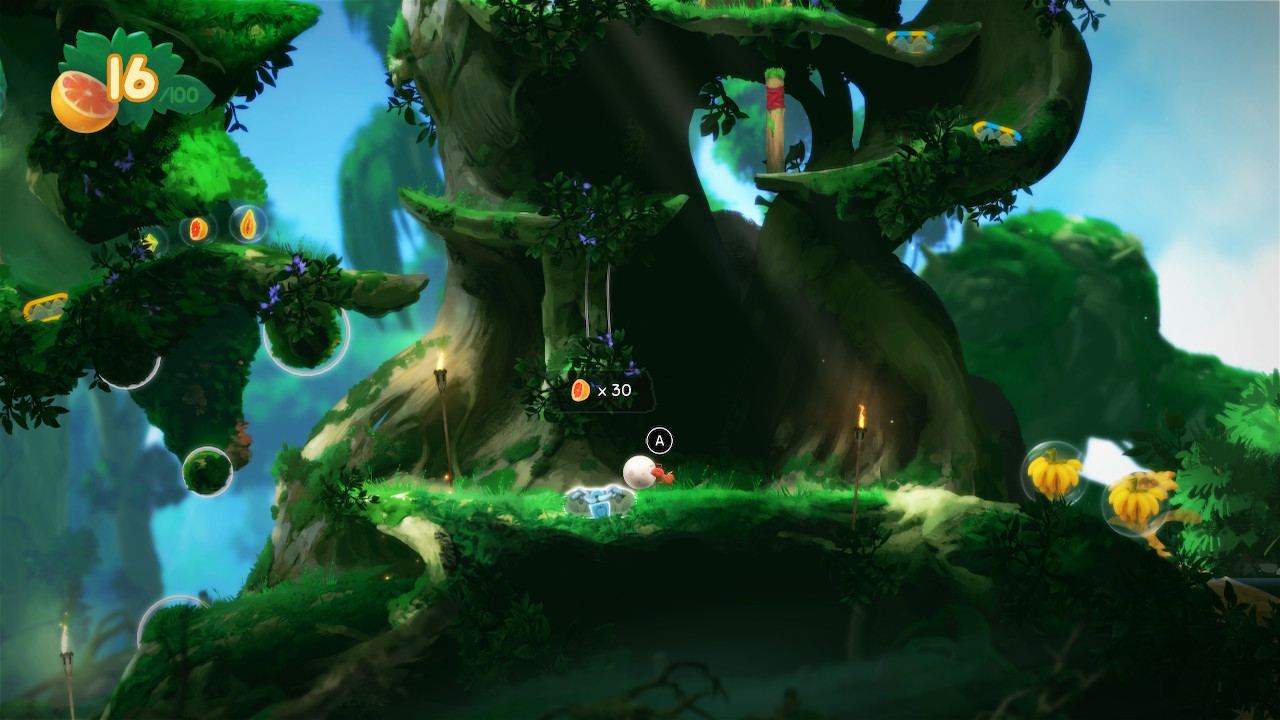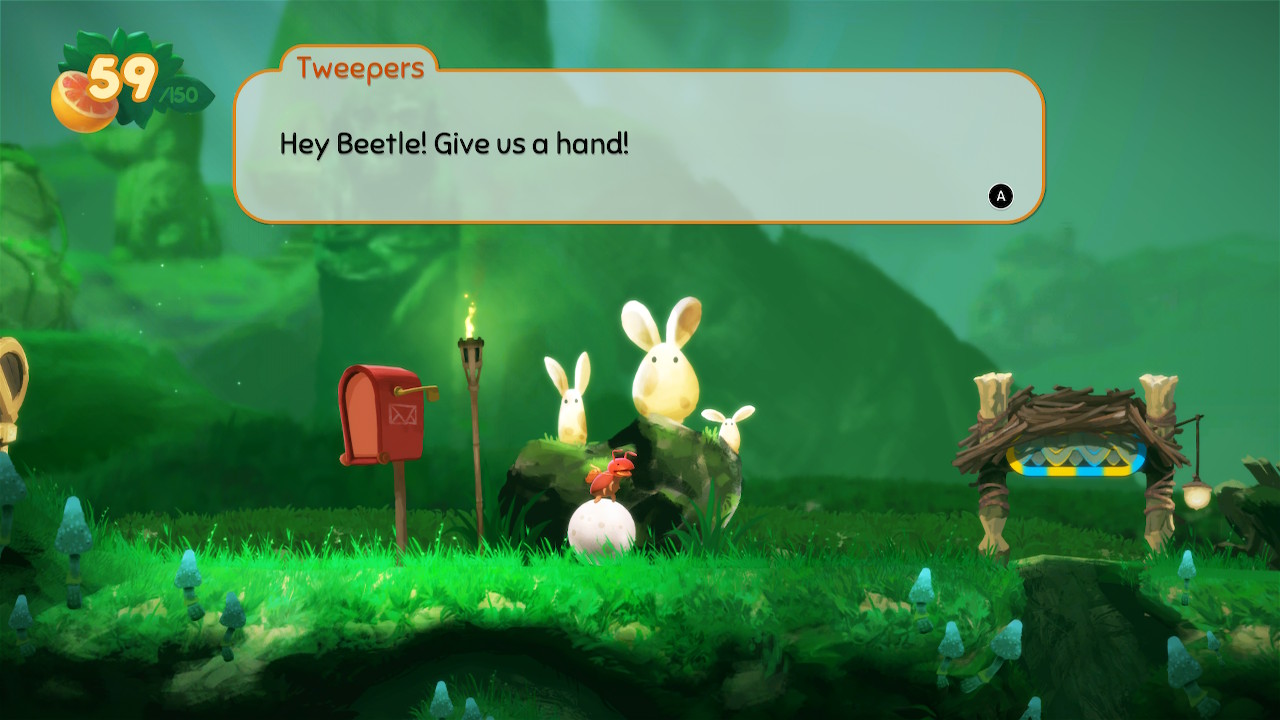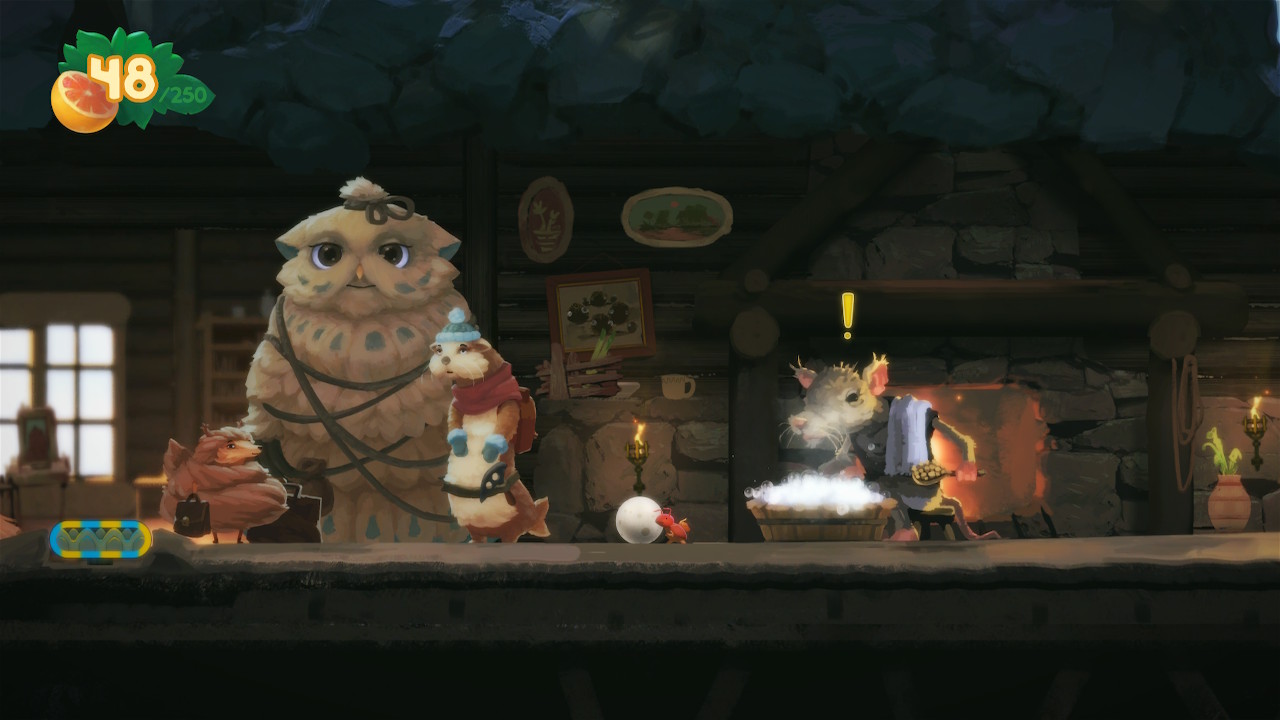Yoku’s Island Express
Yoku’s Island Express is a bewitching combination of arcade pinball mechanics and enchanting metroidvania. But is it more than the sum of its parts, or does the gimmick result in a game which falls short of the two genres’ potential?

Arriving on Mokumana beach as Yoku, a lovable dung-beetle, your movement is constrained by the enormous pinball tied to your belly: you can push it left and right, but that’s about it. Soon, however, you’ll come across the first pinball flipper built into the ground, waiting to propel you forward, and things start opening up. Although some are initially locked, these flippers perform the same function that jumping does, and they vary in placement and angle, offering a far greater range of movement than mere legwork can accomplish.
The game soon introduces a host of metroidvania components, including blocked pathways, plenty of helpful NPCs, and currency (fruit) to collect, in order to purchase items. Pretty soon, you’re exploring the map, finding items to assist your quest, and making progress in much the same way as any other game in the genre.
Despite the familiar approach, Yoku’s Island Express feels open and expansive. Partly, this is due to a finely balanced map which really isn’t locked down that much. Also, the very nature of the environment lends itself to free movement: much of the time you’re outdoors, with plenty of surrounding space, and flippers move you long distances fairly quickly.

Ultimately, those flippers come into their own when they’re attached to one of the many ‘mini-pinball tables’ dotted around the landscape. Most are required to navigate to make progress, and most are blocking you one way or another, until a certain exit is opened or a given condition fulfilled.
Each table typically features a combination of traditional pinball features — bumpers, lanes, drop targets, pegs, rollovers, stoppers — and a few original features such as collectibles to open doors, and slugs to … er … break barriers if you suck them up with a vacuum (don’t worry, it’s explained along the way!).
The tables are abundant in their supply of fruit, and there’s no ‘losing the ball’ as such — if you miss it with the main flippers, it tends to fall into a patch of thorns which remove one solitary piece of fruit. Fruit is everywhere, so this is no hardship, and the more you play each table, the more fruit you’ll gather anyway.
There’s no doubt the tables are a fun distraction, and certainly add an original edge to this metroidvania. As a pinball fan, I appreciate that the mechanics are done well enough to make me feel like I am actually playing a mini game of pinball — there’s no complaint there. Where the tables do fall down, unfortunately, is their simplicity. They are not difficult in the slightest, and tend to be on the small side, with only a handful of features. It feels as though the developers went all-in on the metroidvania, did some excellent work polishing the pinball mechanics to make everything smooth, but then failed to replicate this effort in designing the tables themselves. The tables are a diversion, never really a destination, which is a shame.
A good example is multiball. On a traditional pinball table, multiball is a hectic rollercoaster ride, during which the player can score huge points bonuses. It’s pure fun, and I was really excited when I realised YIE was presenting me with its own version. However, multiball here just serves to highlight how sparse the tables really are: there’s no huge point-scoring, because the game isn’t really about that. And the adrenalin rush just doesn’t kick in when there’s no jeopardy; in fact, multiball becomes a bit of a slog because the aim is for each ball to find a different ‘resting place’, something like those old puzzles with tiny ball-bearings. And those are slow, slow games, they’re not pinball.

It should be obvious from the screenshots, but Yoku’s Island Express is beautiful. The bright, vivid graphics are sure to appeal to younger players, but the whole look is one that anyone should be able to appreciate. Some of the details, particularly in scenes involving NPCs, are incredibly fine, and it’s obvious that a lot of work has gone into refining the look.
As with any metroidvania, there are various themed ‘zones’ ranging from standard ‘grassy outdoors’ to underground caverns and icy tundra. They merge into each other seamlessly, and contribute to an overall map that is sprawling, but manageable. Although some backtracking is involved, it’s not too far from one end to the other, and a ‘fast-travel’ system is waiting to be unlocked too.
It’s a big advantage to be able to see the whole map at any time, and to be able to seamlessly travel across the whole expanse without any significant loading screens interrupting. The ‘map’ view is essentially just a zoomed-out version of the main view you play in. Whilst this looks very nice, it’s a bit of a problem in practice since a map usually benefits from removing and simplifying detail.

The game is brimming with amusing little touches, such as the party whistle you’ll acquire early on. It serves a purpose, but it’s also incredibly charming — I defy anyone to resist instinctively blowing that whistle as they traverse Yoku’s world.
So, fun gameplay, adorable characters, attractive graphics, and an inventive mix of mechanics should result in a knock-it-out-of-the-park hit, right? Unfortunately, Yoku’s Island Express has one significant downside, although just how much it matters will depend on what kind of player you are.
Yoku’s Island Express is easy. Very easy. There is basically no way to die. It’s possible that ‘losing the ball’ in a pinball table, when you have zero fruit, will end your run — I never found out. I doubt few but the youngest players will ever find out, it’s just not that likely to happen.
In the main world, there’s nothing that can harm you at all — even the most dangerous-seeming creatures are benign, and you’ll survive the highest of falls. Sometimes those falls get annoying because of where you end up on the map, but it’s just time you’ll lose, never progress.
It’s difficult to judge how much a difficulty level can affect a game because every player has their own level of skill. But, really, Yoku’s Island Express is so easy, it sometimes felt like I was going through the motions, simply following along with what the game wanted me to do, having less impact than I might have expected. And the ease of the pinball tables combines with the ease of the main adventure in a less-than-satisfying way.

Verdict
😇
So, is Yoku’s Island Express better than the sum of its parts, does it work as a game beyond its tantalising gimmick?
The pinball is fun, but it’s more diverting than engrossing. The main adventure is a bit more captivating, and it’s a wonderful experience, but it’s fairly short, and very straightforward. There’s plenty for completionists to sink their teeth into, though, and this is a perfect game to return to when you’re after a bit of light entertainment.
Yoku’s Island Express is a highly accessible game, and it’s an enjoyable one if you can accept the lack of depth. Anyone who enjoys both the pinball and metroidvania genres is sure to have a good time here. Don’t expect a pure, fully-featured pinball experience, though, and if you’re the type of player who really likes a hard challenge, you might be best served elsewhere.
I played Yoku’s Island Express on Nintendo Switch for 10 hours, maybe half of which was exploration beyond the core story. It works great docked, and although it’s perfectly playable in handheld mode, some of the detail gets a bit lost at the smaller size.
The game was created by Jens Andersson & Mattias Snygg — working as Villa Gorilla — and published by Team 17.